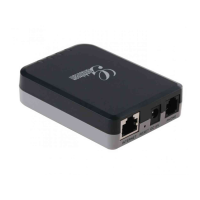HT70X User manual
Version 1.0.9.4
Allow Incoming SIP
Messages from SIP
Proxy Only
Default is No. Check the incoming SIP messages. If they don’t come from the
SIP proxy, they will be rejected. If this option is enabled, the device will not be
able to make direct IP calls.
If set to Default, it will add Privacy header unless special feature is Telkom SA
or CBCOM.
Use P-Preferred-
Identity Header
If set to Default, it will add P-Preferred-Identity header unless special feature is
Telkom SA or CBCOM.
SIP REGISTER
Contact Header Uses
Default is LAN Address. If set to WAN Address, device will detect its WAN
address and use it in SIP REGISTER Contact Header.
T1 is an estimate of the round-trip time between the client and server
transactions.
If the network latency is high, select larger value for more reliable usage. Default
is 0.5 Sec.
Maximum retransmission interval for non-INVITE requests and INVITE
responses. Default is 4 Sec.
Configure the SIP Timer D defined in RFC3261. 0 - 64 seconds. Default 0
Sets the payload type for DTMF using RFC2833. Default is 101.
The HT70X supports up to 3 different DTMF methods including in-audio, via
RTP (RFC2833) and via Sip Info using SIP INFO messages. The user can
configure DTMF method in a priority list.
Default is No. If set to yes, use above DTMF order without negotiation
Generate Continuous
RFC2833 Events
Default is No. If set to yes, RFC2833 events are generated until key is
released.
Default is No. If set to yes, flash will be sent as DTMF event.
Default is No. If set to Yes will overrides the default settings for call control when
both channels are in use.
Default is Yes. (If Yes, call features using star codes will be supported locally)
This parameter allows users to configure a User ID or extension number that is
automatically dialed when off-hook. Only the user part of a SIP address needs
to be entered here. The HT70X will automatically append the “@” and the host
portion of the corresponding SIP address. HT701 and HT702 only.

